belt OLDSMOBILE SILHOUETTE 2003 Owners Manual
[x] Cancel search | Manufacturer: OLDSMOBILE, Model Year: 2003, Model line: SILHOUETTE, Model: OLDSMOBILE SILHOUETTE 2003Pages: 466, PDF Size: 21.55 MB
Page 2 of 466
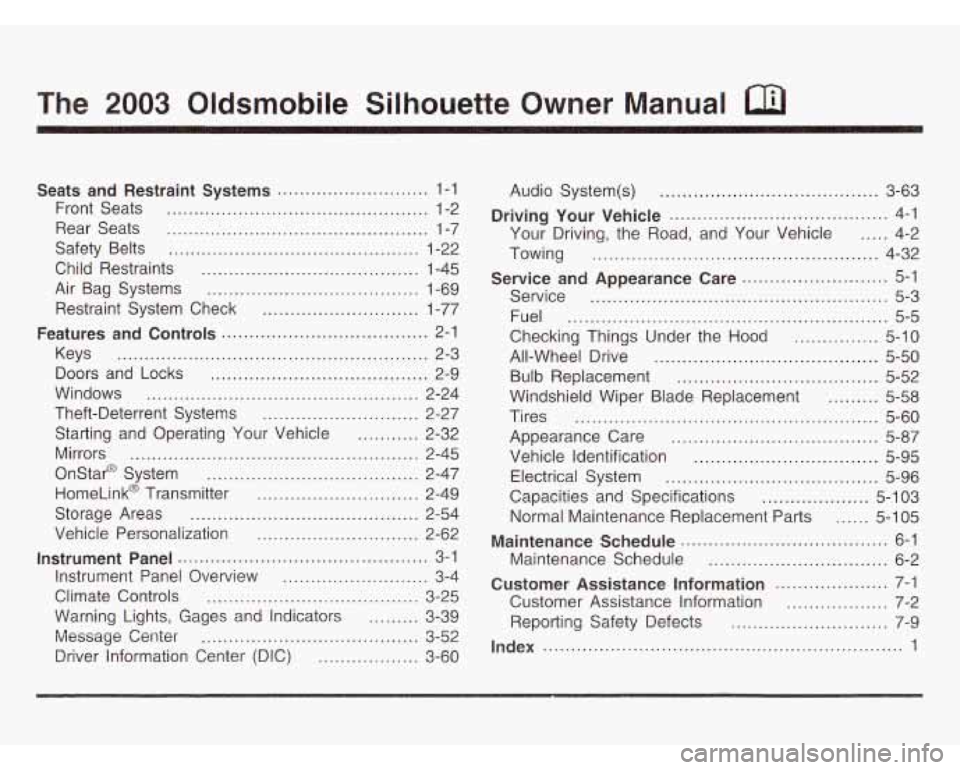
.
The 2003 Oldsmobile Silhouette Owner Manual
Seats and Restraint Systems ........................... 1-1
Front Seats
............................................... 1-2
Rear Seats
............................................... 1-7
Safety Belts
............................................. 1-22
Child Restraints
....................................... 1-45
Air Bag Systems
...................................... 1-69
Restraint System Check
............................ 1-77
Features and Controls
..................................... 2-1
Keys
........................................................ 2-3
Doors and Locks
....................................... 2-9
Windows
................................................. 2-24
Theft-Deterrent Systems
............................ 2-27
Starting and Operating Your Vehicle
........... 2-32
Mirrors
.................................................... 2-45
Onstar@ System
...................................... 2-47
HomeLink@ Transmitter
......................... 2-49
Storage Areas
......................................... 2-54
Vehicle Personalization
............................. 2-62
Instrument Panel Overview
.......................... 3-4
Climate Controls
...................................... 3-25
Warning Lights, Gages and Indicators
......... 3-39
Driver Information Center (DIC)
.................. 3-60
Instrument Panel
............................................. 3-1
Messaye Center 5-3L n r~ .......................................
Audio
System(s) ....................................... 3-63
Your Driving, the Road, and Your Vehicle
..... 4-2
Towing
................................................... 4-32
Service
..................................................... 5-3
Fuel
......................................................... 5-5
Checking Things Under the Hood
............... 5-10
All-Wheel Drive
........................................ 5-50
Bulb Replacement
.................................... 5-52
Windshield Wiper Blade Replacement
......... 5-58
Tires
...................................................... 5-60
Appearance Care
..................................... 5-87
Vehicle Identification
................................. 5-95
Electrical System
...................................... 5-96
Capacities and Specifications
................... 5-1 03
Normal Maintenance Replacement Parts
...... 5-1 05
Maintenance Schedule
................................ 6-2
Customer Assistance Information
.................... 7-1
Customer Assistance Information
.................. 7-2
Reporting Safety Defects
............................ 7-9
Driving Your Vehicle
....................................... 4-1
Service and Appearance Care
.......................... 5-1
Maintenance Schedule
..................................... 6-1
Index
................................................................ 1
Page 6 of 466
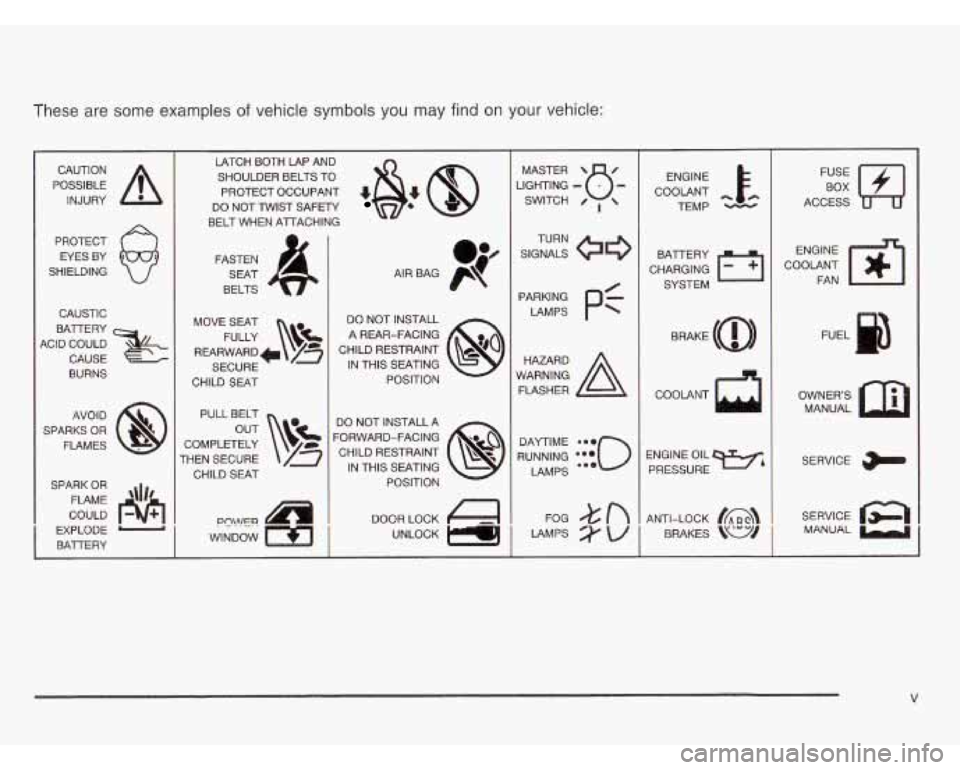
I 'hese are some examples of vehicle symbols you may find on your vehicle:
POSSIBLE A
CAUTION
INJURY
PROTECT
EYES BY
SHIELDING
CAUSTIC
BATTERY
4CID COULD
CAUSE
BURNS
AVO1 D
SPARKS
OR
FLAMES
SPARK
OR
FLAME '\I/'
COULD
EXPLODE
---I
BATERY 1
LATCH BOTH LAP AND SHOULDER BELTS TO
PROTECT OCCUPANT MASTER ENGINE
DO NOT TWIST SAFETY
TEMP
BELT WHEN ATACHING
FASTEN SEAT
BELTS
MOVE SEAT FULLY
\!$k=
REARWARD+ /z
SECURE
CHILD
SEAT
PULL BELT
COMPLETELY
THEN SECURE
CHILD SEAT AIR BAG
DO NOT INSTALL A REAR-FACING
CHILD RESTRAINT IN THIS SEATING
POSITION DO NOT INSTALLA n I
TURN
SIGNALS
PARKING LAMPS
HAZARD
WARNING FLASHER
pf
COOLANT
l.fJ
ACCESS
ENGINE
COOLANT FAN
OWNERS MANUAL
SERVICE
SERVICE
a MANUAL
V
Page 8 of 466
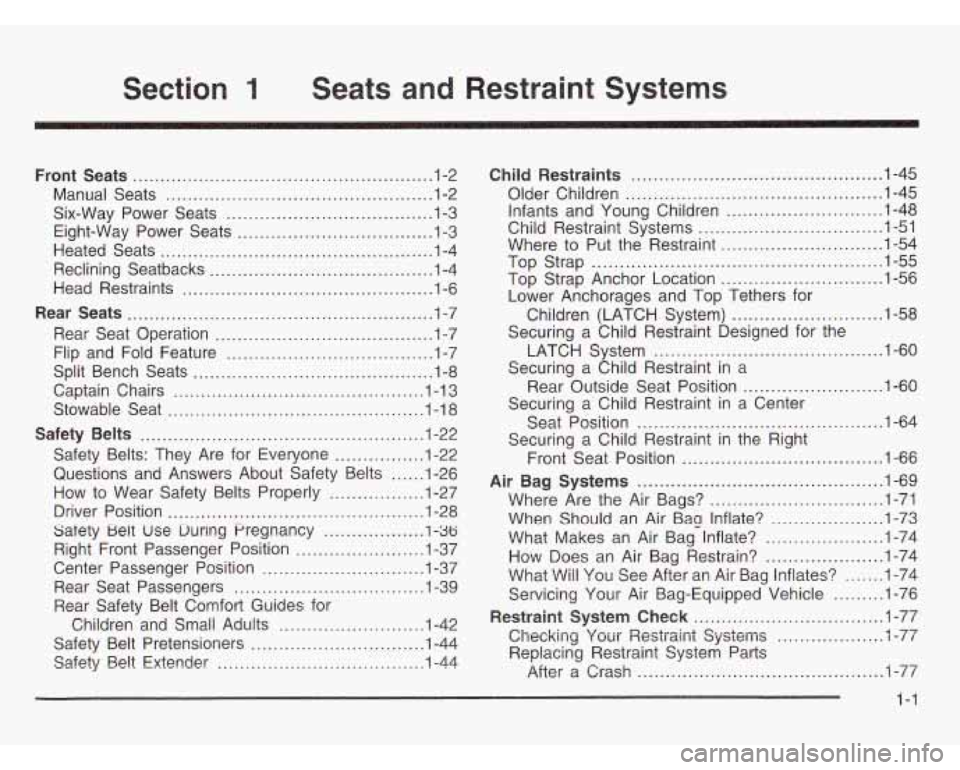
1 Seats and Restraint Systems
Front Seats ............................... ......... 1.2
Manual Seats
............................ ............. 1 -2
Six-Way Power Seats
..................................... 1-3
Eight-Way Power Seats
................................... 1-3
Heated Seats
................................................. 1-4
Reclining Seatbacks
........................................ 1-4
Head Restraints
............................................. 1-6
Rear Seats
....................................................... 1-7
Flip and Fold Feature ..................................... 1-7
Split Bench Seats
........................................... 1-8
Captain Chairs
............................................. 1-1 3
Stowable Seat ............................................. -1 -1 8
Safety Belts: They Are for Everyone
................ 1-22
Questions and Answers About Safety Belts
...... 1-26
How
to Wear Safety Belts Properly ................. 1-27
Driver Position
.............................................. 1-28
Satety Beit use During Pregnancy
.................. 1-36
Rear Seat Operation ....................................... 1-7
Safety Belts
................................................... 1-22
Right Front Passenger Position
....................... 1-37
Center Passenger Position
............................. 1-37
Rear Seat Passengers
.................................. 1-39
Rear Safety Belt Comfort Guides for
Children and Small Adults
.......................... 1-42
Safety Belt Extender
..................................... 1-44
Safety Belt Pretensioners
..... ................... 1 -44 Child Restraints
............................................. 1-45
Older Children
.............................................. 1-45
Infants and Young Children
............................ 1-48
Child Restraint Systems
................................. 1-51
Where to Put the Restraint ............................. 1-54
Top Strap
.................................................... 1-55
Top Strap Anchor Location ............................. 1-56
Lower Anchorages and Top Tethers for
Securing a Child Restraint Designed for the
Securing a Child Restraint in a
Securing a Child Restraint in a Center
Securing a Child Restraint in the Right
Children (LATCH
System)
........................... 1-58
LATCH System
......................................... 1-60
Rear Outside Seat Position
......................... 1-60
Seat Position
............................................ 1-64
Front Seat Position
.................................... 1-66
Air
Bag Systems ............................................ 1-69
When Should an Air Bag Inflate? ................ 1-73
What Makes an Air Bag Inflate?
..................... 1-74
How Does an Air Bag Restrain?
..................... 1-74
What Will You See After an Air Bag Inflates?
....... 1-74
Servicing Your Air Bag-Equipped Vehicle
......... 1-76
Restraint System Check
.................................. 1-77
Where Are
the Air Bags?
........................... 1-71
Checking
Your Restraint Systems 1 -I 1 477 ...................
Replacing Restraint System Parts
After a Crash
............................................ 1-77
1-1
Page 12 of 466

But don’t have a seatback reclined if your vehicle
is moving.
Sitting in a reclined position when your vehicle
is in motion can be dangerous. Even if you
buckle up, your safety belts can’t do their job
when you’re reclined like this.
The shoulder belt can’t do its job because
it
won’t be against your body. Instead, it will be
in front of you. In a crash you could go into
it,
receiving neck or other injuries.
The lap belt can’t do its job either. In a crash
the belt could
go up over your abdomen.
The belt forces would be there, not at your
pelvic bones. This could cause serious internal injuries.
For proper protection when the vehicle is in
motion, have the seatback upright. Then sit
properly.
1I I- - -1. K- rl_- ---I -.--‘I ___ --#,-a*. L-11 WSII UaGK 111 Lilt: Jt:a~ allU Wtxu ~UI aalely U~IL
1 -5
Page 18 of 466
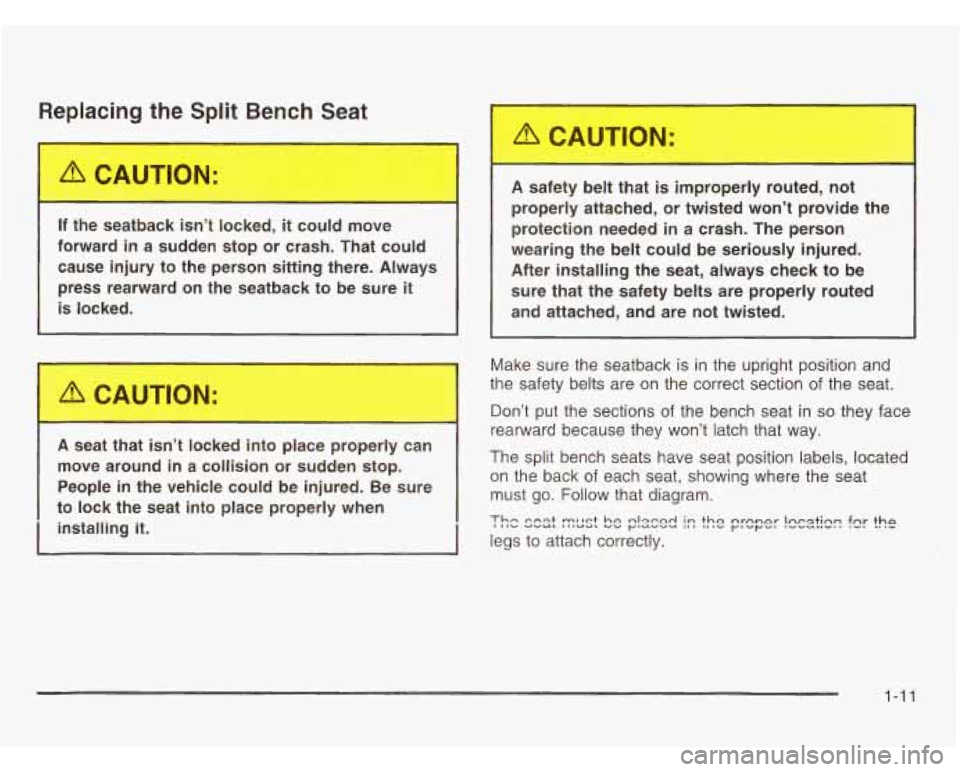
Replacing the Split Bench Seat
If the seatback isn’t locked, it could move
forward in a sudden stop or crash. That could
cause injury to the person sitting there. Always press rearward on the seatback to be sure
it
is locked.
A seat that isn iocked into place properly can
move around in a collision or sudden stop.
People in the vehicle could be injured. Be sure
to lock the seat into place properly when
I installing it.
I
A safety belt that is improperly routel , not
properly attached, or twisted won’t provide the
protection needed in a crash. The person
wearing the belt could be seriously injured.
After installing the seat, always check to be
sure that the safety belts are properly routed
and attached, and are not twisted.
Make sure the seatback is in the upright position and
the safety belts are on the correct section
of the seat.
Don’t put the sections of the bench seat in
so they face
rearward because they won’t latch that way.
The split bench seats have seat position labels, located
on the back of each seat, showing where the seat
must
go. Follow that diagram.
1-1 1
Page 23 of 466
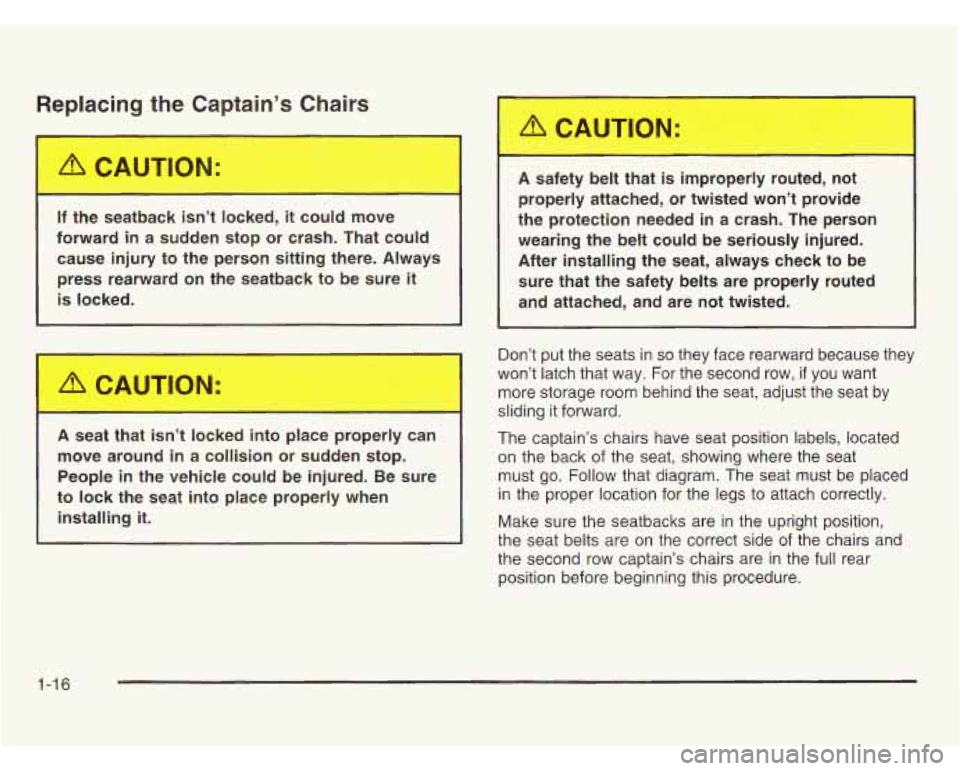
Replacing the Captain’s Chairs
If the seatback isn’t locked, it could move
forward in a sudden stop or crash. That could cause injury to the person sitting there. Always press rearward on the seatback to be sure
it
is locked.
A seal lat isn’t locked into place properly can
move around
in a collision or sudden stop.
People
in the vehicle could be injured. Be sure
to lock the seat into place properly when
installing
it.
A safety belt that is improperly routed, not properly attached, or twisted won’t provide
the protection needed
in a crash. The person
wearing the belt could be seriously injured.
After installing the seat, always check to be
sure that the safety belts are properly routed
and attached, and are not twisted.
Don’t put the seats in
so they face rearward because they
won’t latch that way. For the second row,
if you want
more storage room behind the seat, adjust the seat by
sliding it forward.
The captain’s chairs have seat position labels, located
on the back of the seat, showing where the seat
must
go. Follow that diagram. The seat must be placed
in the proper location for the legs to attach correctly.
Make sure the seatbacks are in the upright position,
the seat belts are on the correct side
of the chairs and
the second row captain’s chairs are in the full rear
position before beginning this procedure.
1-16
Page 27 of 466
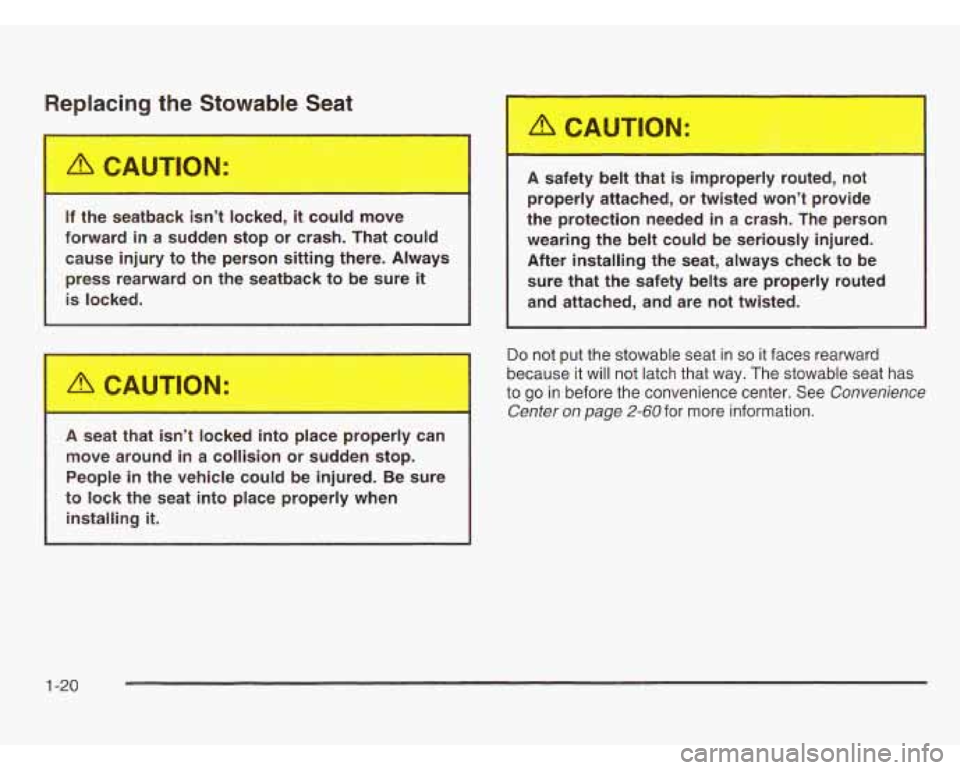
Replacing +he Stowable Seat
If the seatback isn’t locked, it could move
forward
in a sudden stop or crash. That could
cause injury to the person
sitting there. Always
press rearward on the seatback to be sure
it
is locked.
A seat that isn’t ~_cked into place properly can
move around in a collision or sudden stop.
People in the vehicle could be injured. Be sure
to lock the seat into place properly when
installing
it.
A safety belt that is improperly routed, not
properly attached, or twisted won’t provide
the protection needed in a crash. The person
wearing the belt could be seriously injured.
After installing the seat, always check to be
sure that the safety belts are properly routed
and attached, and are not twisted.
Do not put the stowable seat in so it faces rearward
because
it will not latch that way. The stowable seat has
to
go in before the convenience center. See Convenience
Center
on page 2-60 for more information.
1-20
Page 29 of 466
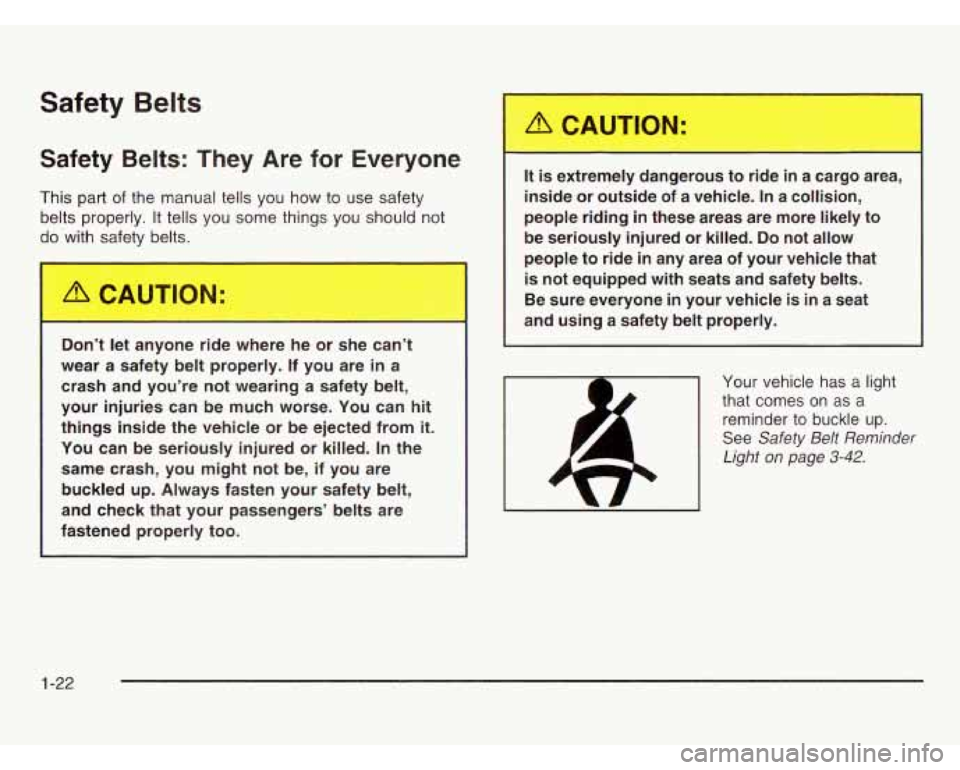
Safety Belts
Safety Belts: They Are for Everyone
This part of the manual tells you how to use safety
belts properly.
It tells you some things you should not
do with safety “-lts.
Don’t let anyone ride where he or she can’t
wear a safety belt properly. If you are
in a
crash and you’re not wearing a safety belt,
your injuries can be much worse. You can hit
things inside the vehicle or be ejected from it.
You can be seriously injured or killed. In the
same crash, you might not be, if you are
buckled up. Always fasten your safety belt,
and check that your passengers’ belts are
fastened properly too.
It is extremely dangerous to ride in a cargo area,
inside or outside of a vehicle.
In a collision,
people riding
in these areas are more likely to
be seriously injured or killed.
Do not allow
people to ride in any area of your vehicle that
is not equipped with seats and safety belts.
Be sure everyone in your vehicle is in a seat
and
using a safety belt properly.
Your vehicle has a light
that comes
on as a
reminder to buckle up.
See
Safety Belt Reminder
Light on page
3-42.
1-22
Page 30 of 466
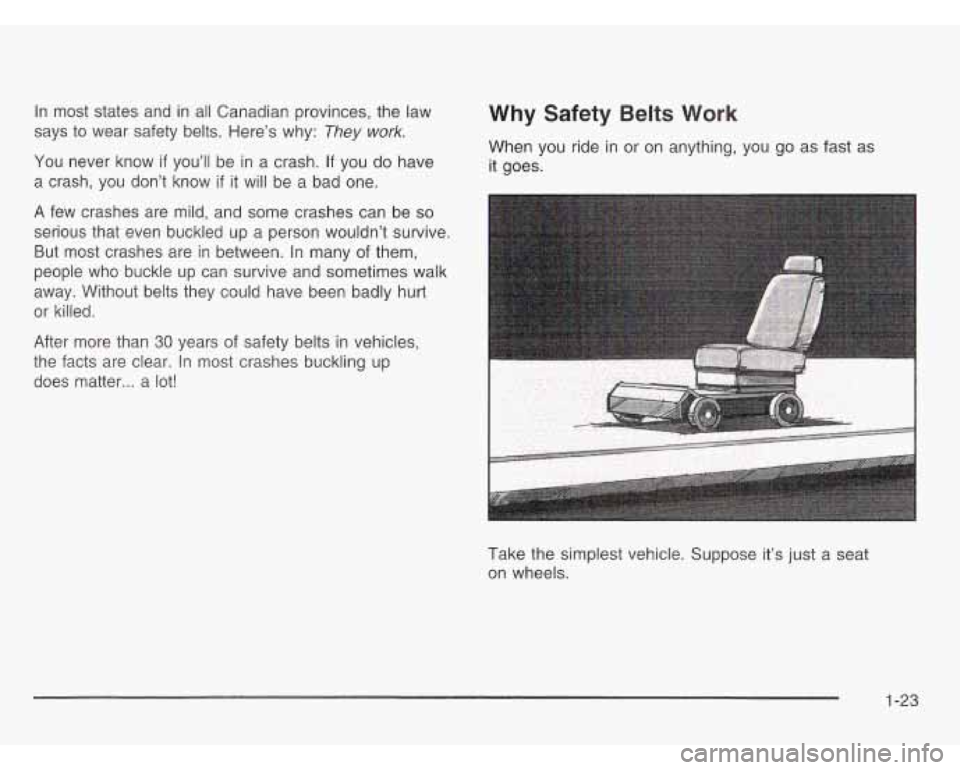
In most states and in all Canadian provinces, the law
says
to wear safety belts. Here’s why: They work.
You never know if you’ll be in a crash. If you do have
a crash, you don’t know
if it will be a bad one.
A few crashes are mild, and some crashes can be
so
serious that even buckled up a person wouldn’t survive.
But most crashes are in between. In many of them,
people who buckle up can survive and sometimes walk
away. Without belts they could have been badly hurt
or killed.
After more than
30 years of safety belts in vehicles,
the facts are clear. In most crashes buckling up
does matter
... a lot!
Why Safety Belts Work
When you ride in or on anything, you go as fast as
it goes.
Take the simplest vehicle. Suppose it’s just a seat
on wheels.
1-23
Page 33 of 466
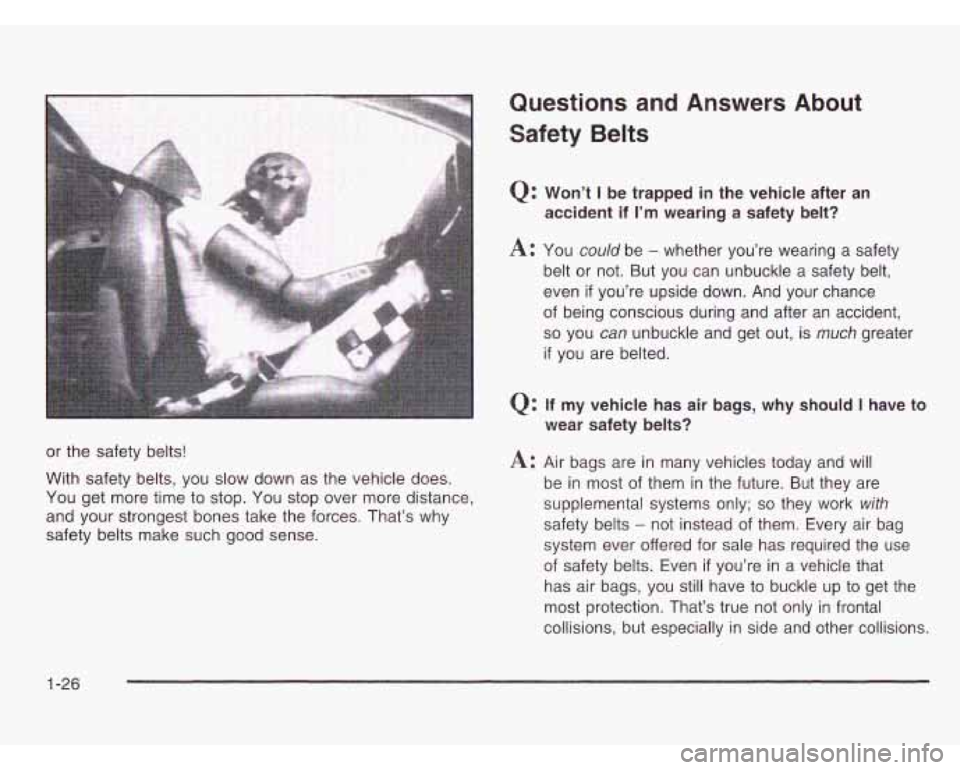
or the safety belts!
With safety belts, you slow down as the vehicle does.
You get more time to stop. You stop over more distance,
and your strongest bones take the forces. That’s why
safety belts make such good sense. A: Air bags are in many vehicles today and will
be in most of them in the future. But they are
supplemental systems only;
so they work with
safety belts - not instead of them. Every air bag
system ever offered for sale has required the use
of safety belts. Even
if you’re in a vehicle that
has air bags, you still have to buckle up to get the
most protection. That’s true not
only in frontal
collisions, but especially in side and other collisions.
1-26